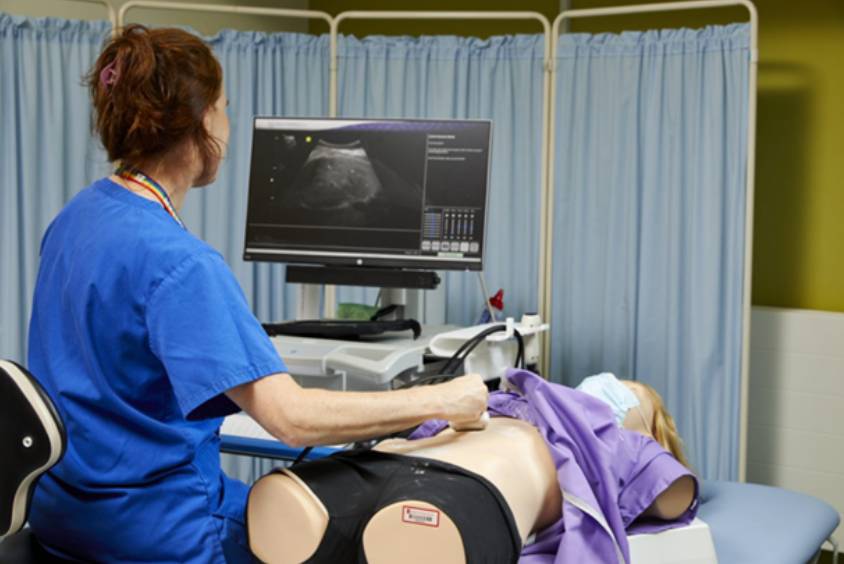How degree apprenticeships are training the sonographers of the future
By Dr Trudy Sevens, deputy chair of the Sonographer Trailblazer Group and lead radiographer, South Yorkshire and Bassetlaw Imaging Network
If you work in ultrasound in the UK, you don’t need me to tell you that there’s a national shortage of sonographers.
A combination of increased demand, poor retention rates and not enough new trainees has led to a shortfall, leading the NHS reliant on expensive agencies to maintain services.
Since 2016, I’ve been part of a group of experts tackling this challenge through the establishment of a new route into the sonography profession: higher and degree apprenticeships.
Here in South Yorkshire, we’re using a successful apprenticeship programme to train new sonographers, and it’s clear from my experience that it’s going to be a crucial part of the NHS’s plan to train, retain and reform ultrasound services in the UK.
Why we had to change
Let me take you back to 2016. There was a huge shortfall in sonographers — 20% nationally, and up to 40% in some areas. Trusts were struggling to retain existing staff and recruit enough new talent into the profession.
At the time, training was limited to a number of postgraduate courses, which weren’t able to train the numbers of applicants the service required.
There was also no career structure in place. If you worked as a sonographer there was nowhere for you to progress, leading to many people choosing to move into other lines of work such as education.
At the same time, there was a 7% increase in demand for sonography services, driven in part by an increased need for cancer diagnoses.
All in all, it was a perfect storm. It was clear something needed to be done.
Our vision
Here at Sheffield Hallam University, we were keen to tackle these challenges. We had a vision for sonographers to be recognised, registered and have a clear career trajectory.
We decided to develop an undergraduate path into ultrasound via a degree apprenticeship. These allow employees to combine full-time work with academic study. Apprentices receive a salary while studying, and pay no tuition fees. The costs are instead covered by the government through the apprenticeship levy, a tax paid by large organisations to fund training.
We set up a trailblazer group to develop the apprenticeship occupational standard. Launched in 2017, it includes twelve employer organisations, seven higher education institutes, and professional bodies like the Society of Radiographers, the British Medical Ultrasound Society (BMUS), the Consortium for the Accreditation of Sonographic Education (CASE) and the Institute for Apprenticeships.
This stakeholder experience is important. As the UK’s second largest higher education provider of higher and degree apprenticeships, we’re used to working with employers to ensure our courses teach the right skills and knowledge needed in the service. As such, our health and social care apprenticeships have been developed with clinicians, education specialists and service users over many years.
Another benefit of apprenticeships is that they allow employers to invest in their own staff, giving opportunities to staff members like imaging support assistants who might want to become a sonographer but couldn’t afford to go down the traditional degree route.
A fresh start for sonography
At the same time as the degree apprenticeship development, BMUS developed a Sonographer Career Framework, which sets out clearly defined and titled job roles for sonographers — and a career progression ladder.
Combined with the newly developed undergraduate CASE standards of education, these meant we could use the apprenticeships to standardise training and meet the ultrasound requirements of the NHS. Apprentices emerge at practitioner level, with a clear list of what they are able to do and how to develop their role further.
In 2022, the first ever degree apprenticeship in ultrasound was approved for delivery here at Sheffield Hallam. Our first cohort of apprentices started the three-year programme in March 2023. After the first year, all were thriving and making a positive contribution to their departments.
The future
The same year, the NHS published the Allied Health Professions Strategy for England 2022 to 2027. In short, it aims to have the right people in the right place at the right time.
Through our work in the trailblazer group we are working to increase the capacity for training, increase services, and use staff skill mix to improve the service. In other words, train, retain and reform. This is our long-term plan.
To be successful we need to listen to sonographers, be flexible and allow them to develop to the top of their practice. We also need to raise awareness of apprenticeships. We are currently conducting a longitudinal study, seeking the views of apprentices and employers to help with this.
Ultimately, as our apprentices enter the workforce people will see the benefits of these courses. There is already a high demand for these apprenticeships, with hundreds of applications for each place. But there is still a 12% shortfall of sonographers nationally.
I am confident that through the combination of apprenticeships, increased job satisfaction, and a clear career structure, we can ensure that sonography in the UK has a bright future.
-

Sonographer
Learn alongside skilled health professionals to become a qualified medical sonographer, fulfilling your ambition to provide diagnostic imaging and patient care.
